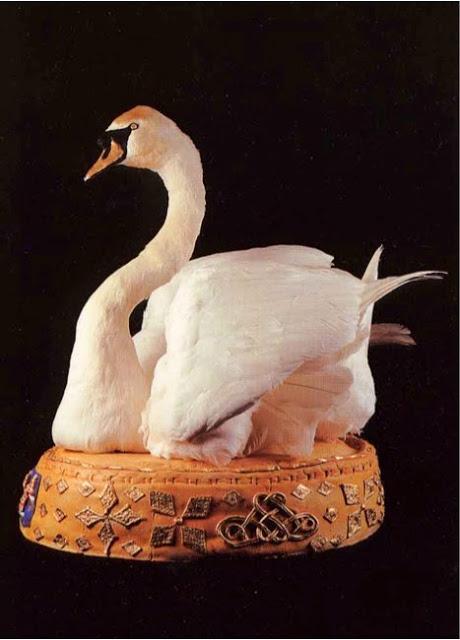
A swan pie I made for the exhibition 'London Eats Out' held at the Museum of London in 2000.
I have just listened to a BBC radio news item about the remains of a mute swan discovered a few days ago on Baths Island in the Thames not far from Windsor Castle. The state of the bird indicated that it had been killed, skinned and then grilled on a disposable barbecue. Thames police have indicated that since swans are the property of the Crown, the case would be treated as one of theft. Mute swans also have statutory protection under the Wildlife and Countryside Act. Very few of us nowadays have had the dubious pleasure of dining on this regal bird, but I am pretty sure that the hooligans who killed this one would not have enjoyed their illegal alfresco meal. In a newspaper photograph the charred left-overs of their supper appeared to belong to an adult specimen. Mature swans have little subcutaneous fat and their flesh is exceedingly dry, making them a tough and entirely unsuitable subject for barbecuing. It would have tasted awful. Serves them right I say. But we all know that swans were once eaten with relish by the wealthy at great feasts, one of the reasons why they were coveted by the crown. But if they are such poor eating what was the fuss all about? Well swan once really was an esteemed dish, but it was not the adult birds that ended up in the pot (or on the grill for that matter). This is what Ross Murray, a compiler of household manuals for Victorian housewives told his readers in the 1870s,'Roast Swan. This splendid dish, worthy of a prince's table, is only too locally known. It is, of course, only eligible for the table in its cygnet state.'
So it looks like they ate the babies - the ugly ducklings that is? Not exactly. Murray goes on to say,
'The cygnets when all hatched are of a slaty grey, which grows lighter as they grow older. The cygnets of the wild swan are white. But it is of the gray cygnets we have to speak. They are hatched in June. If if is intended to eat them they must be taken from their parents and put into a separate swan pond, at the end of August or first week in September. After they have been "hopped or upped", as it is called, from their native place grass is thrown to them twice a day with their other food for a fortnight. They are fattened on barley: a coomb each cygnet suffices for the fattening. The corn is set in shallow tubs just under water. Cygnets can only be fattened before the white feathers appear; after that no feeding will do any good; as soon as a white feather shows they will cease fattening, no matter what food they have. They can consequently only be eaten in December, and they are a capital and magnificent Christmas dish. Their weight then will be from 25 lbs to 28 lbs.'*
So the teenage super-sizer swans were fattened by feeding each of them on a coomb of barley. A coomb was a dry measure consisting of four bushels! That was some fattening up process. They were slaughtered the moment their white adult plumage appeared, which pretty well coincided with Christmas. They were seven months old. Murray goes on to tell us that swan was a popular local dish in Norfolk and explains how they were roasted in homes in that county on a spit in front of the fire as a Christmas dish. He explains that the finished swan was garnished with four little swans carved out of turnips and 'a paper frill, nicely cut, about the shoulders'. He even quotes a popular Norfolk poem on how to prepare the bird and provides a chromolithograph of the finished roast garnished with its miniature turnip swans. Both poem and illustration are reproduced below.
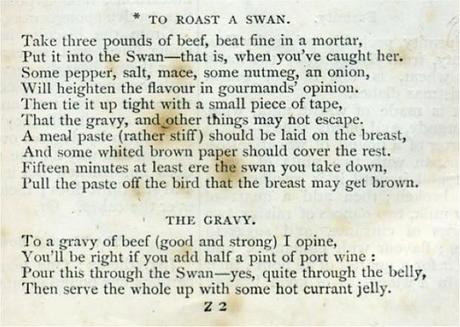
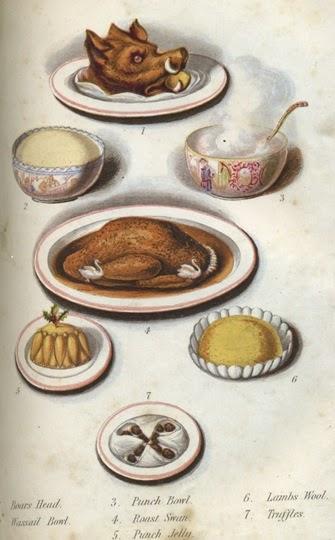
So if ordinary Norfolk folk, other than the ones who resided at Sandringham, ate swan at Christmas were they breaking the law of the land like the two heartless criminals who murdered the Baths Island bird the other day? No. Because the swans they roasted on their spits were probably not the property of the monarch. The Crown could only claim ownership of those birds which had not been marked by other owners. For centuries swans' bills were cut with identifying marks that indicated the identity of the 'swannery' to which they belonged. Abbots, Bishops and other wealthy landowners frequently raised young swans for their tables and all marked their bird's bills with distinguishing marks. These swan marks were granted by the Crown to the various owners. It was a similar process to the one of being issued by the Crown with a license to have a deer park on your estate. The marks illustrated below were granted to various owners resident in Lincolnshire. This practice was considered to be cruel to the swans by Queen Alexandra and it was discontinued in the early twentieth century.
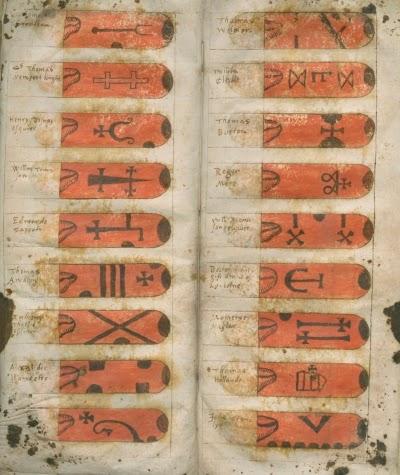
Royal Society MS 106 pp 6-7. Sixteenth century swan bill marks compiled by Elizabeth I's swan master. The various swan owners are identified to the left of the diagrams. Courtesy of the Royal Society.

A sixteenth century book of swan bill marks. Harley MS. 3405 ff. 18v-19. Courtesy of British Library
So swans were not only kept for looking pretty on your lake or moat, but had a definite gustatory purpose. As early as the thirteenth century they were an item of commerce and were being sold in markets as food. In fact they were eaten all over Europe and are frequently depicted in table still life paintings. In 2000 I recreated a 1566 livery company feast in which swan pies featured for an exhibition at the Museum of London. I used a painting by David Teniers the Younger (reproduced below) as a model for the pies which had gilded pastry decorations as well as a taxidermy specimens of swana sitting on top.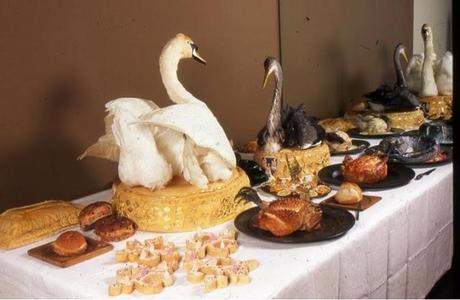
A recreated 1566 livery company feast at the Museum of London
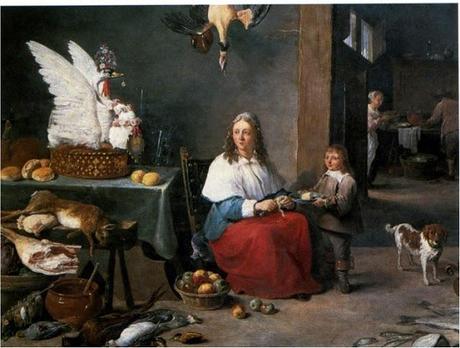
David Teniers the Younger, Kitchen Scene with Swan Pie. 1644 The Mauritshaus, The Hague.
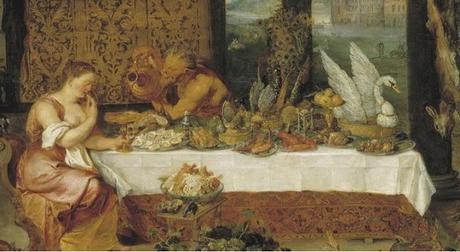
Jan Breughel the Elder, An Allegory of Taste (detail). 1618. The Prado, Madrid
In England, of course swan featured on Christmas menus. Below is the bill of fare for a Christmas day feast published by the seventeenth century master cook Robert May. In the first course item 11 is 'A swan roast'. The second course is regaled with item 6 'A Swan Pye'.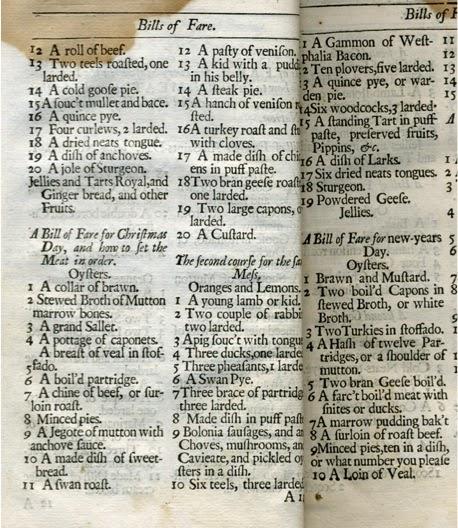
From Robert May, The Accomplisht Cook. (London: 1660)
Nearly a hundred years after May published the bill of fare above, another Christmas dinner featuring a swan pie, this time as a centrepiece for the first course appeared in John Thacker's The Art of Cookery (Newcastle upon Tyne: 1758). Thacker was the cook to the Dean and Chapter at Durham Cathedral where there had been a swannery since well before the Reformation. He gives us a recipe which indicates that the Dean's Christmas Swan Pie would have been ornamented in the style of those depicted in the paintings above.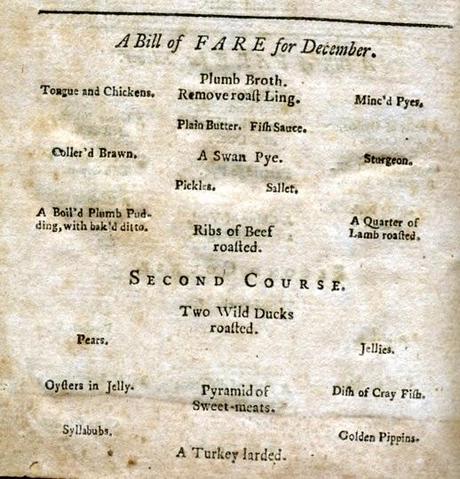
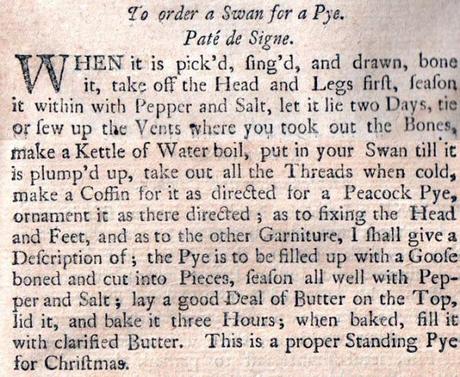
Bill of fare and recipe from John Thacker, The Art of Cookery (Newcastle upon Tyne: 1758)
By the nineteenth century, swan had gone out of fashion (other than in the wilds of Norfolk). However, the use of taxidermy swans to embellish fancy food items continued, as witness this bizarre trophy of woodcocks, snipe and other game birds illustrated by Thomas Garrett in the 1890s.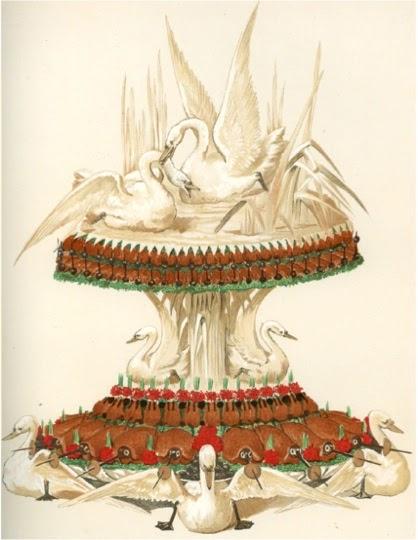
Although roast swan and swan pie had vanished swans made of butter, ice cream, aspic, nougat, chocolate and countless other confections graced the tables of the Victorian wealthy. Mould manufacturers had a field day producing swans in copper, tin, pewter and wood for kitchen staff to make these decorated dishes.
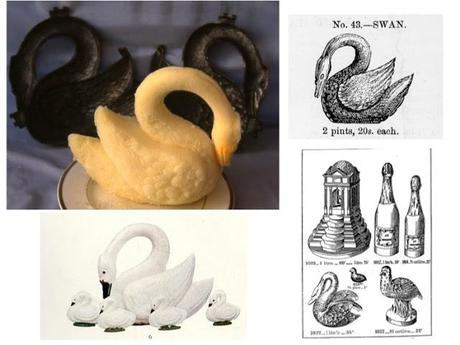
Ice cream and sorbet swans were very popular on the high Victorian table
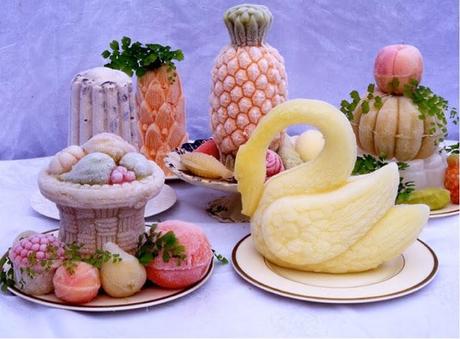
An ice cream swan did not require a license from the crown

One half of a butter print in the form of a swan
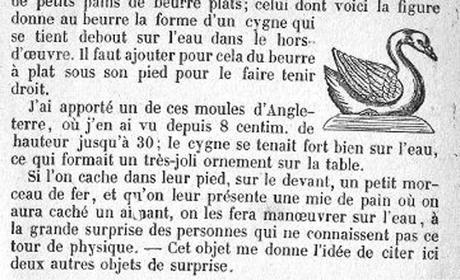
I found this cutting in a Victorian scrapbook. I do not know its original French source. It explains how the English performed a trick at the table by concealing a small piece of iron in a butter swan and then with a magnet hidden in a piece of bread, encouraged the swan to swim across a wet plate!
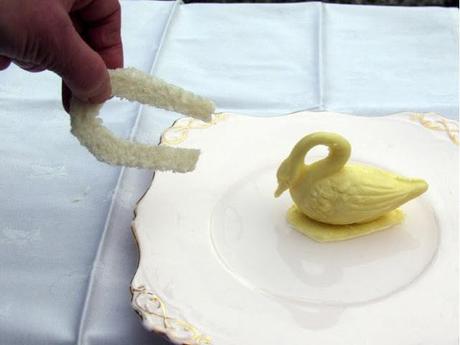
So with a magnet discreetly sealed in a piece of bread I had a go. It worked!
*Ross Murray, The Modern Householder, A Manual of Domestic Economy. (London: nd. 1870s) pp. 338-9.
